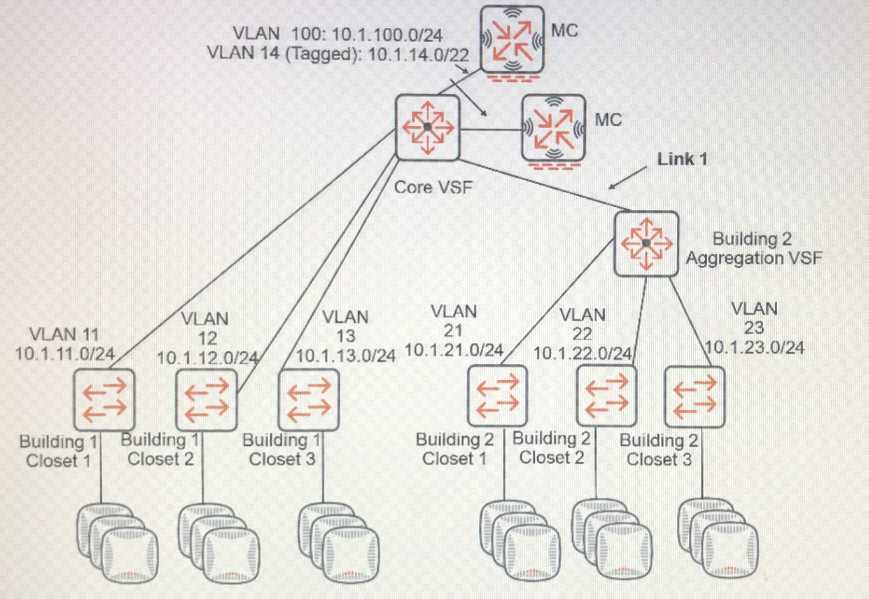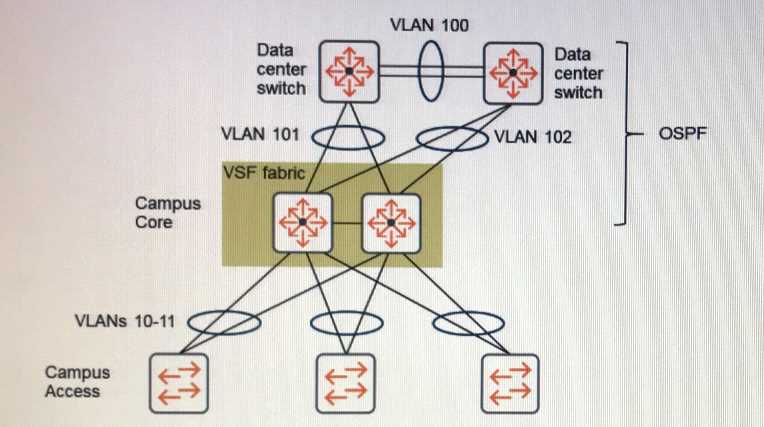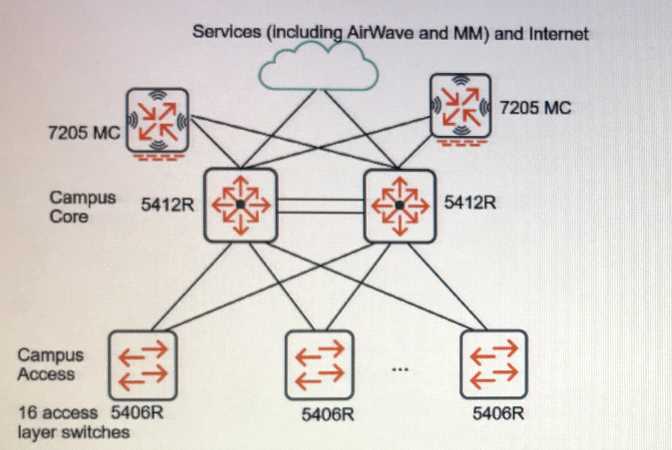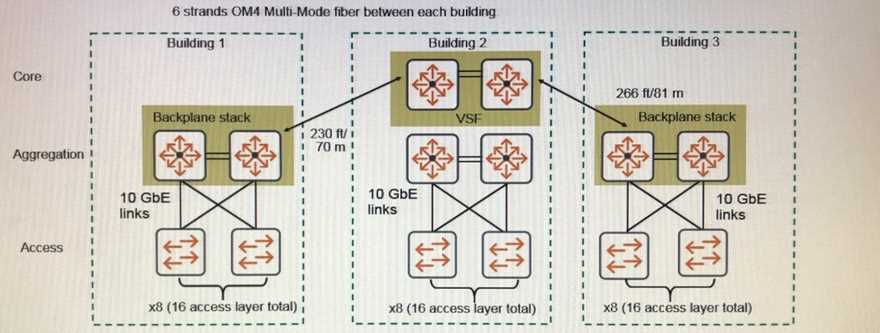HP HPE6-A47 Exam Questions
Questions for the HPE6-A47 were updated on : Jun 28 ,2025
Page 1 out of 4. Viewing questions 1-15 out of 60
Question 1
Refer to the exhibit.
The customer needs to expand its wired and wireless network to a new building, Building 2, which is
near the existing building, Building 1. The exhibit shows the logical plan that the architect has
created so far. The aggregation layer switches in the new building should provide the default gateway
services for the VLANs in the new building and route traffic to the core. The existing Aruba Mobility
Controllers (MCs) will control the new APs.
What should be the VLAN assignment for Link 1, indicated in the exhibit?
- A. an unused VLAN such as 200
- B. VLANs 21, 22, and 23 only
- C. VLANs 11, 12, 13, 21, 22, and 23
- D. the default VLAN and VLAN 14
Answer:
C
Question 2
Read this scenario thoroughly, and then answer each that displays on the right side of the screen.
An architect proposes these products for a customer who wants a wireless and wired upgrade:
1. Aruba 2930M switches at the access layer
2. Aruba 5406R switches at the core
3. Aruba AP-325s
4. Aruba 7205 Mobility Controllers (MCs), deployed in a cluster
5. Aruba Mobility Master (MM)
6. Aruba ClearPass Cx000V
7. Aruba AirWare
The architect also needs to propose a security plan for the solution. The customer has 900 employees
and up
to 30 guests a day. The customer wants to protect the internal perimeter of the network with
authentication and
simple access controls. The customer is most concerned about wireless security, but also wants to
ensure that
only trusted users connect on the wire. However, the customer also wants all wired traffic to be
forwarded
locally on access layer switches. The customer already has a third-party firewall that protects the data
center.
The customer wants to use certificates to authenticate user devices, but is concerned about the
complexity of
deploying the solution. The architect should recommend a way to simplify. For the most part users
connect
company-issued laptops to the network. However, users can bring their own devices and connect
them to the
network. The customer does not know how many devices each user will connect, but expects about
two or
three per-user. DHCP logs indicate that the network supports a maximum of 2800 devices.
Refer to the provided scenario. Which ClearPass licenses should the architect include in the
proposal?
- A. 1,000 Access licenses and 1000 Onboard licenses
- B. 1,000 Access licenses and 3,000 (3x1000) Onboard licenses
- C. 3,000 Access licenses (3x1000) and 1000 Onboard licenses
- D. 3,000 Access licenses and 3,000 (3x1000) Onboard licenses
Answer:
B
Question 3
Read this scenario thoroughly, and then answer each that displays on the right side of the screen.
An architect proposes these products for a customer who wants a wireless and wired upgrade:
1. Aruba 2930M switches at the access layer
2. Aruba 5406R switches at the core
3. Aruba AP-325s
4. Aruba 7205 Mobility Controllers (MCs), deployed in a cluster
5. Aruba Mobility Master (MM)
6. Aruba ClearPass Cx000V
7. Aruba AirWare
The architect also needs to propose a security plan for the solution. The customer has 900 employees
and up
to 30 guests a day. The customer wants to protect the internal perimeter of the network with
authentication and
simple access controls. The customer is most concerned about wireless security, but also wants to
ensure that
only trusted users connect on the wire. However, the customer also wants all wired traffic to be
forwarded
locally on access layer switches. The customer already has a third-party firewall that protects the data
center.
The customer wants to use certificates to authenticate user devices, but is concerned about the
complexity of
deploying the solution. The architect should recommend a way to simplify. For the most part users
connect
company-issued laptops to the network. However, users can bring their own devices and connect
them to the
network. The customer does not know how many devices each user will connect, but expects about
two or
three per-user. DHCP logs indicate that the network supports a maximum of 2800 devices.
Refer to the provided scenario. Based on the plan for wired authentication, what is a correct plan for
wired user
VLANs?
- A. use the MCs to assign wired users to their VLANs, and extend the VLANs to a Layer 3 switch connected to the MC
- B. specify the VLANs in network policies on AirWare, and ensure that both the switches and MCs are managed by AirWare
- C. assign wired users to different VLANs from wireless users, based on port or role assignments on access layer switches. Extend the VLANs to the core.
- D. configure the same roles on switches and MCs to place wired and wireless users in the same VLANs. Extend VLANs from access layer switches to the core.
Answer:
C
Question 4
Read this scenario thoroughly, and then answer each that displays on the right side of the screen.
An architect proposes these products for a customer who wants a wireless and wired upgrade:
1. Aruba 2930M switches at the access layer
2. Aruba 5406R switches at the core
3. Aruba AP-325s
4. Aruba 7205 Mobility Controllers (MCs), deployed in a cluster
5. Aruba Mobility Master (MM)
6. Aruba ClearPass Cx000V
7. Aruba AirWare
The architect also needs to propose a security plan for the solution. The customer has 900 employees
and up
to 30 guests a day. The customer wants to protect the internal perimeter of the network with
authentication and
simple access controls. The customer is most concerned about wireless security, but also wants to
ensure that
only trusted users connect on the wire. However, the customer also wants all wired traffic to be
forwarded
locally on access layer switches. The customer already has a third-party firewall that protects the data
center.
The customer wants to use certificates to authenticate user devices, but is concerned about the
complexity of
deploying the solution. The architect should recommend a way to simplify. For the most part users
connect
company-issued laptops to the network. However, users can bring their own devices and connect
them to the
network. The customer does not know how many devices each user will connect, but expects about
two or
three per-user. DHCP logs indicate that the network supports a maximum of 2800 devices.
Refer to the provided scenario.
Which solution should the architect recommend on the 2930M switches to authenticate and control
wired
employee devices?
- A. MAC-Auth on edge ports and no tunneled node
- B. 802.1X on edge ports and per-user tunneled node
- C. 802.1X on edge ports and no tunneled node
- D. Mac-Auth on edge ports and per-user tunneled node
Answer:
A
Question 5
An architect needs to choose between an Aruba Mobility Controller (MC) 7010 or 7024. Which
customer need
indicates that the 7024 is a better choice than the 7010?
- A. the need to support 2000 users or devices
- B. the need to support PoE+
- C. the need to manage 20 APs
- D. the need to connect 20 APs directly to the MC
Answer:
A
Question 6
A customer has very high availability requirements for wireless services. The architect plans to
implement
clustering on several Aruba Mobility Controllers (MCs). Which benefit of this feature should the
architect
explain?
- A. Clustering provides wireless client load balancing and seamless failover for client sessions.
- B. Clustering provides high stability because one MC is active for all sessions and one is standby for all sessions.
- C. Clustering enables an AP with a failed MC to operate on its own briefly to ensure seamless connectivity.
- D. Clustering enables an AP with a failed MC to reconnect to a new AP after a short bootstrap.
Answer:
B
Question 7
Refer to the exhibit.
The customer requires fast failover if any one link or core device fails. Which additional technology
should the
architect plan on the core VSF fabric to meet these criteria?
- A. OSPF graceful restart
- B. SmartLink
- C. BGP
- D. VRRP
Answer:
C
Question 8
An architect needs to plan a wireless deployment. The architect conducts a physical walkthrough, but
still
needs more information. Which significant RF obstacle can be difficult to see visually and might
require access
to blueprints?
- A. fiberglass
- B. metal firewall
- C. ceiling tiles
- D. drywall
Answer:
A
Question 9
Refer to the exhibit.
What is one reason for an architect to recommend the use of Virtual Switching Framework (VSF) in
this
network?
- A. VSF enables software-defined network monitoring in conjunction with AirWare.
- B. VSF transforms switches into virtual extensions of the MCs to simplify MST management.
- C. VSF enables administrators to manage all 18 switches as a single switch.
- D. VSF simplifies the topology and eliminates the need for spanning tree.
Answer:
D
Question 10
An architect needs to plan 802.11ac wireless deployment for an office environment with a mix of
closed offices
and cubicles. The coverage area is approximately 4,645 square meters (approximately 50,000 square
feet)
and has 350 users. The employees use the wireless network for typical office applications, such as
email,
Web, printing, and accessing shared files and datacenter services.
The architect plans to do a predictive site survey and use VisualRF to plan the coverage. What is a
general
estimate for the AP count that the architect should have in mind?
- A. 5-10
- B. 10-15
- C. 20-25
- D. 40-45
Answer:
D
Question 11
An architect needs to plan an 802.11ac wireless upgrade for a university building. What is one reason
that it is
important for the architect to identify auditoriums?
- A. Auditoriums typically require a high-density AP design for RF coverage.
- B. Users in Auditoriums often have Bluetooth devices, which can be a source of interface in the 5 GHz band.
- C. Auditoriums typically require the use of 80 MHz channels to meet bandwidth requirements.
- D. Auditoriums often require the use of DFS channels for sufficient 20 MHz channels.
Answer:
D
Question 12
An architect needs to deliver an upgrade to an 802.11ac-based solution for a customer. The customer
requires
an active site survey for the new deployment. Which deliverable should the architect provide to the
customer?
- A. a heat map with proposed AP locations and actual tested coverage
- B. a heat map with existing AP locations and actual tested coverage
- C. a heat map with sources of RF interface, both 802.11 and non-802.11
- D. the heat map with proposed AP locations and predictive coverage
Answer:
C
Question 13
Refer to the exhibit.
An architect determines that 80 Gbps bandwidth is required for the link aggregation between the
Building
1aggregation layer and Building 2. Which transceivers should the architect recommend for each pair
of
switches?
- A. two QSPF+ BiDi
- B. two QSPF+ MPO
- C. eight SPF+ LR
- D. eight SFP+ SR
Answer:
B
Question 14
An enterprise needs an upgrade to 802.11ac. Users run applications such as Web, email, voice, and
video.
The architect needs to conduct an active site survey to plan 802.11ac AP locations. The noise floor is
about -
90 dBm across the site.
Based on Aruba best practices, what is the minimum acceptable signal that the architect should look
for to
determine the test AP range?
- A. a signal of -65 dBm in the 2.4 GHz band
- B. a signal of -75 dBm in the 5 GHz band
- C. a signal of -65 dBm in the 5 GHz band
- D. a signal of -75 dBm in the 2.4 GHz band
Answer:
C
Question 15
An RF plan specifies wide sector directional antennas.
Refer to the antenna specifications.
H-plane refers to the Azimuth or Horizontal plane and E-plane refers to Elevation or Vertical plane.
Antenna 1: H-plane = 360; E-plane = 120
Antenna 2: H-plane = 360; E-plane = 60
Antenna 3: H-plane = 100; E-plane = 90
Antenna 4: H-plane = 60; E-plane = 60
Which antenna specifications indicate that the antenna is a good choice for the plan?
- A. Antenna 1
- B. Antenna 2
- C. Antenna 3
- D. Antenna 4
Answer:
B